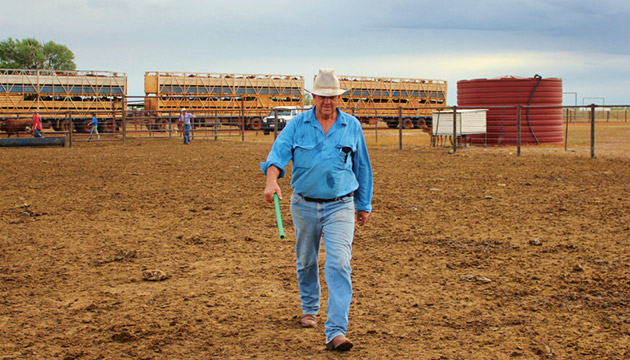Prominent Northern Territory cattleman Ross Peatling reflects on more than two decades managing “the best cattle property in Australia”.
Story By Kerry Sharp
Ross Peatling was just another face in the crowd at his first Warwick cattle sale on Queensland’s Darling Downs in June. No-one knew that this unassuming bidder with an uncanny eye for a good beast had just spent 23 years managing 77,000 cattle on Australia’s second biggest station, Alexandria, on the Barkly Tableland.
“I loved the sale today,” says Ross, who handed over the reins of the 1.6 million-hectare North Australian Pastoral Company (NAPCo) property in April to move with wife Robyn to a 32ha former grain-growing farm just outside Warwick. “We bought six Santa Gertrudis heifers today to fatten up and sell, and one Angus heifer to eat,” he says. “The paddocks looked a bit lonely with no cows in them!” His stocking priority is logical for a man who saw 660,000 calves branded and 630,000 cattle turned off in his time on Alexandria.
Unlike most of his pastoral peers, Queenslander Ross came from a long line of ‘non-bush’ people – but that didn’t stop this son of a Childers sugar-mill accountant reaching the pinnacle of station jobs. He left school in Year 10 and became a foundation student at Longreach Pastoral College in 1967, then found jackaroo work around central Queensland and northern New South Wales before joining Stanbroke Pastoral Company in 1972 and becoming Stanbroke Station’s head stockman within 12 months. He also worked at Fort Constantine at Cloncurry and Havilah at Collinsville before accepting his first manager’s job at Wondoola, in the Queensland Gulf country, in 1980. That set the scene for management postings on the Territory’s Mount Bundy, Elsey and Hodgson Downs stations and the livestock coordinator’s job at Twynam Pastoral Company’s Gunnee Feedlot in New South Wales.
A surprise phone call from NAPCo’s then general manager Ross Brunckhorst in 1991 gave the young cattleman his biggest break – the chance to manage Alexandria, the sprawling Barkly ‘calf factory’ established in 1877 on the near-treeless Mitchell grass tablelands, 173 kilometres north-west of Camooweal and 273km east of Tennant Creek.
“He was clearly the best candidate for the job,” Ross says. “He’d done the hard yards and brought enormous industry knowledge and expertise with him, and he wasn’t frightened of hard work. He came in on the early stages of our composite-breeding program, which was one of the most successful initiatives of its kind in the world, and he took charge and carried it through to where it is today.”
This Story is from Issue #96
Outback Magazine: Aug/Sep 2014










